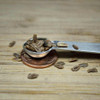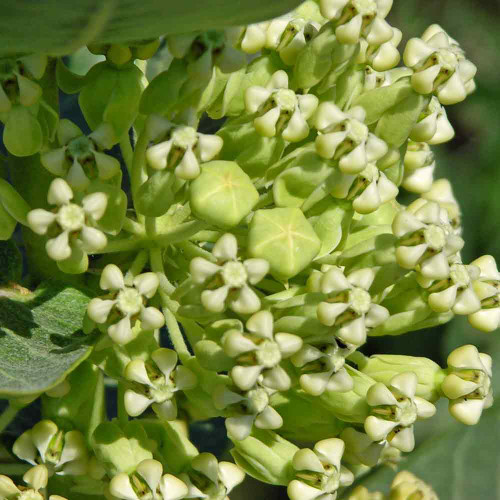Description
Whorled Milkweed - Unassuming Yet Important
Whorled Milkweed – Asclepias verticillata – is a petite, pretty, and rather delicate-looking native perennial that excels as a butterfly host plant providing food and habitat for Monarch Butterflies along with attracting scores of other pollinators.
Unlike its more dramatic siblings, Whorled milkweed blends in with grasses and is easily overlooked when not in bloom, but don’t let that fool you. It spreads prolifically via rhizome roots, and stays quite short for milkweed – rarely growing taller than two feet – but the sheer amount of leaf material can feed an army of hungry caterpillars. Once established in grasslands and prairies, its biomass probably exceeds that of all other milkweeds.
Many home gardeners have commented that Whorled Milkweed attracted more Monarchs and caterpillars than they’ve ever seen, even finding several chrysalides and witnessing Monarch butterflies emerging.
Sprays of abundant, tiny, fragrant white flowers bloom from mid-summer into autumn – among the last milkweeds to go dormant. This is a very valuable late-season food source for Monarch butterflies and their caterpillars.
The flowers also attract many solitary bees as well as honeybees, different wasp species, moths, butterflies, and skippers that drink nectar from the flowers, and crab spiders often hide in the clusters, hunting them. Small Milkweed Bugs, Milkweed Leaf Beetles, and Yellow Milkweed Aphids feed on the foliage, while ladybugs prey on the aphids.
In short, Whorled Milkweed is bustling with pollinators.
Hummingbirds love this plant, are attracted to the flowers, and use the fibers from the seeds as nesting material, making it an excellent choice for bird gardens and sanctuaries.
Details
Whorled Milkweed is a pioneer species, meaning it grows first, establishing itself and stabilizing the soil prior to being shaded out by other, usually taller native plants that come after. It is one of the most widespread milkweed species in North America, the happiest growing on neglected, exposed soils with low nutrients and little competition.
Habitats include upland prairies, sand prairies, gravel prairies, hill prairies, openings in rocky upland forests, sandy savannas, limestone glades, rocky bluffs along major rivers, bluegrass meadows, pastures and abandoned fields, grassy slopes along highways, fallow fields, open woods, and waste areas.
Thanks to these traits, it is often used in restoration projects for dry prairies and meadows or simply to naturalize a neglected plot of land.
Asclepias verticillata is a deep-rooted North American native perennial that forms colonies from its root system, which is fibrous and rhizomatous. If allowed, the rhizomes will spread and produce numerous clones.
As an early succession species, Whorled Milkweed naturally spreads into unoccupied spaces but other, taller perennials will eventually outcompete it. Use this trait to your benefit by thinning seedlings to provide space for adult plants to thrive and spread. Alternatively, densely plant taller surrounding plants as a barrier to slow their spread. Both of these approaches, as well as deadheading, help to manage their numbers.
Please note, this species has one of the highest concentrations of cardiac glycosides, the toxins taken up by Monarch larvae as a defense mechanism against predators. It is poisonous to livestock and horses and should not be allowed to spread into pastures or other grazing areas. Due to the toxins, it is extremely bitter and is usually avoided by most animals.
Flowering Time
May through September
Will These Grow in My Area?
The range of these milkweed species is not limited to Arizona but in most cases the entire southwest and beyond. Refer to the USDA map link and please realize that a milkweed species can grow and thrive outside of the areas listed if the conditions are favorable.
From that link, you’ll see the states shown where the milkweed is native. If you find a state that has areas with climate and conditions similar to yours, then that milkweed will most likely do very well for you.
Whorled Milkweed can grow in a huge variety of places and conditions. But is most commonly found in ditches, roadsides, along railroads, and in drier locations where competition from taller plants isn’t significant. In prairies with average moisture Whorled Milkweed can be shaded out.
Pods
Milkweed pods contain a seed floss – called pappas – that is used to stuff pillows or mixed with other fibers to make a cloth. It is used in Life Jackets or as a stuffing material. It is very water-repellent. Floss is the mechanism for seed dispersal.
After blooming, narrow erect pods (roughly 3.5″ long by 1/2″ wide) will form. Like other Milkweeds, the pods of Whorled Milkweed will be packed with small flat seeds attached to white feathers/hair.
Why This Milkweed is Special
This milkweed seed is of the highest quality available anywhere. It is hand-grown across central and northern Arizona, hand-harvested, hand-cleaned, and hand-packed. Over the past five years, it has been test-grown in different elevations to verify its vigor and adaptability to different conditions.
Terroir Seeds is proud to be the exclusive partner in offering these unique milkweed seeds to home gardeners. The sale of each packet of milkweed seeds directly supports the continued, ongoing research of Arizona Milkweeds for Monarchs organization, a dedicated volunteer citizen science research organization that is overseen by professional scientists from Northern Arizona University.
The milkweed plant (Asclepias spp.) plays a critical role in the Monarch’s life cycle. Each spring Monarchs move across the United States, laying eggs on native milkweed, the only plant that serves as food for newly hatched monarch caterpillars. Arizona has more than 40 species of milkweed - more than 50% of the total diversity of milkweeds in the continental US - giving it the second greatest diversity of milkweeds next to Texas.
Other Names
- Linear-leaved Milkweed
- Eastern Whorled Milkweed
- Eastern Horsetail Milkweed
Growing Tip
In the fall when the milkweed pods split open and the seeds are flying out on the breeze, they have a natural germination-inhibiting coating on them so that they don’t sprout too early and die off during the winter.
Moisture and abrasion act on the seed coating to soak and wear it off in nature, allowing moisture into the seed in early spring to start the germination process.
Cold-wet stratification is easy to do at home and significantly increases the germination rate before planting them.
Here’s how to do it – label a sandwich-sized ziplock bag with the name of the milkweed and date, then fill it about 3/4 full with sand, decomposed granite, or another abrasive media. Add enough water to make the sand very wet – you should see the sheen of water when you squish the bag. Add the seeds – however many you want to plant – to the mixture and place the baggie on the top shelf of your fridge, where you can move it a couple of times daily.
This cool, wet, abrasive action mimics a winter in nature while starting the germination process.
Once a month has passed, plant your seeds as usual.
Uses
Native American uses include:
The roots were used as a stimulant, sudorific, diaphoretic, and as a snake bite remedy by the Choctaw.
An infusion of the entire plant was taken by nursing mothers to improve milk flow by the Hopi and Lakota.
The Hopi also used larger stems as planting sticks, and young shoots and leaves were boiled with meat and eaten.
Used for nose and throat troubles by the Navajo.
Learn More
- Milkweed, Monarchs and Home Gardeners to the Rescue
- Milkweed Seed Germination Procedures
- Growing Milkweed for the Monarch Butterfly
- Planting A Pollinator Feast
From the soil to the seed to the food you eat - we'll help you grow your best garden!
1 Review
-
Good Stuff
The seeds germinated well. Hopefully next year I'll get some nice flowers from this highly beneficial native.















